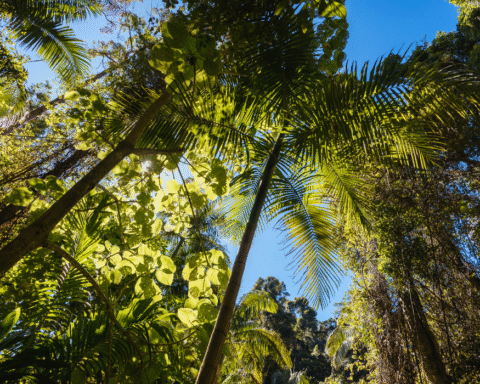WET’SUWET’EN, Canada — The pilot flew over squares of clear-cuts and tree plantations, then rolled the helicopter around Hudson Bay Mountain in north-central British Columbia. We were following directions from David de Wit, the acting director of the Office of the Wet’suwet’en, who was navigating from a map of traditional trails in their territory.
On the ground, the trails are marked by culturally modified trees, circles carved into bark, proof of the Wet’suwet’en Nation’s history in this area. As we approached Caas Tl’aat Kwah (aka Serb Creek), a 15,054 hectare watershed that has not yet been logged or mined, the forest stitched together in a blanket of deep green, cleaved only by yellow-green wetlands threaded with glacial blue streams.
“We want to conserve it for future generations,” says Charlotte Euverman, the Wet’suwet’en woman leading a fight to save this area, which includes a traditional gathering and feasting site. “We have to leave them something.”
Like most First Nations here, the Wet’suwet’en never signed treaties with Canada or the province. Nevertheless, the latter took the land and leased forested areas to logging companies. Today just 20% of British Columbia’s old-growth forests remain. In 2020, after decades of activist pressure, the province released its Old Growth Strategic Review, a report that identified about a quarter of the remaining old growth as high risk for logging and recommended a pause while land-use decisions were made. Yet four years on, logging has been deferred in less than half of the high-risk area.
First Nations and an array of species have paid dearly for the wide-scale logging, and now some forestry experts say its effects are being felt farther afield too.
Scientists are finding that industrial logging can contribute to the intensity and frequency of forest fires because it dries out the land. In summer 2023, more than 150,000 square kilometres (58,000 square miles) burned across Canada, an all-time record, carrying smoke across the continent and air pollution all the way to Europe and China.
Despite promises from the province’s Ministry of Forests, environmental activists say that classic “talk and log” delay tactics continue. Independent analysis by the Wilderness Committee, Sierra Club BC and Stand.earth found that 50,000 to 100,000 hectares (123,000 to 247,000 acres) of the at-risk forests have been logged or approved for logging in British Columbia since the province’s 2020 report.
“With so little old growth left, it is crucial [for the province] to step up to the plate for watersheds like Serb Creek and offer nations every support needed for long-term solutions,” says Jens Wieting, senior forest and climate campaigner with Sierra Club BC.
RELATED:
Tree planting in the face of wildfires
Canadian boreal wildfires drove up carbon emissions last year
The fire beast is everywhere. A checklist for fighting back.
Before boarding the helicopter, de Wit leads us in a ceremony, inviting us to rub charcoal on our cheeks. It’s a sign to their ancestors that we’re coming with respect, he explains, acknowledging that they reside on the land and that alpine places are sacred. Because the area is not yet accessible by road, nation members Caroline Muir and Sandra Harris are seeing it for the first time.
After 30 minutes of flying, the pilot waggles the helicopter down, setting it upon a boggy meadow. As we step out, Muir takes a moment, eyes closed, hand on her heart. Harris stoops to examine the plants: low cedar (Diphasiastrum complanatum), Labrador tea (Ledum groenlandicum Oeder), frilly white bogbean (Menyanthes trifoliata) flowers.
Harris’s great-grandfather and Muir’s great-uncle, Jack Joseph, had a cabin here. It’s gone now, but we follow de Wit through the trees to a newer cabin. He opens his backpack and pulls out a framed photo of Joseph and nails it to the wall in a place of pride.
Harris explains the significance of this moment for her. “We have a lot of stress in our lives with racism, working with colonial systems that are so unkind to our ways.” The land is healing, she says.
“Today, we can feel our ancestors. We remember our stories when we are able to put our feet on the land,” Harris says. “My spirit needs that . . . There’s lots of good medicine there for us.”
Where there’s logging, there’s fire
Canadian governments’ commitments to reconciliation with First Nations and to biodiversity conservation might lead the Ministry of Forests to spare some of the remaining old growth. But the rise in extreme fires does not appear to factor into its calculus, says Torrance Coste, associate director of the Wilderness Committee. The link between logging and fires is “absolutely not” acknowledged by the province, he says.
Yet Coste says that industry lobby groups use the threat of wildfire to argue for more logging, saying, “We need to log these areas so they don’t burn.” That argument is driven by the conventional wisdom that increased fire severity is due not just to climate change but also fire suppression that created “fuel loading” – dense growth.
The Ministry of Forests would not make someone available for an interview. But a spokesperson wrote in an email that their approach to reducing wildfire severity is thinning (some logging) and prescribed burns.
Dominick DellaSala, chief scientist for Wild Heritage, says that thinning forests reduces fire severity only in narrow circumstances. “It’s critical to leave large, fire-resistant trees in place,” he says, and not to remove too much of the forest canopy, which dries out plants and soil and allows winds to blow fires longer distances. Even if done right, benefits last only about a decade, he says, and thwart fire only when the weather isn’t too hot or dry.
Susan Prichard, a fire ecologist at the University of Washington, says thinning can be a helpful step before prescribed burns in certain ecosystems, such as interior Douglas fir and ponderosa pine forests that Indigenous Peoples used to burn regularly. Outlawing the practice has led to overgrowth. Caas Tl’aat Kwah, on the other hand, contains interior cedar hemlock and Engelmann spruce subalpine fir ecosystems, with trees up to 350 years old. Prichard says thinning or prescribed burns in these types of forests would not reduce fire severity.
DellaSala and other scientists say that the focus on fuel loading and thinning fails to recognize the way in which industrial logging increases fire severity: it kills complex communities of life that stabilize the water cycle, leading to much drier landscapes.
One paper that DellaSala co-authored looked at the severity of 1,500 fires in Western U.S. states over 30 years and found that protected forests, with higher levels of biomass [plants] and fuel loading, actually had lower fire severity than intensively managed areas of commercial logging. Another from 2018 found that “intensive plantation forestry characterized by young forests and spatially homogenized fuels, rather than pre-fire biomass, were significant drivers of wildfire severity.” Another from 2022 found that clear-cutting was a key factor leading to “frequent, high-severity fire.”
Other studies suggest that old growth reduces fire severity by retaining moisture and helping to generate rain. In an intact forest, dense, layered canopies of multiple species slow rain when it falls, and roots provide pathways for water to move underground. From there, it filters into creeks, wetlands and rivers over weeks and months. As trees photosynthesize, they release water vapour into the air, forming clouds.
They also release particles of microbes and fungi that help vapour coalesce into rain. Their rough surfaces slow wind, keeping moisture in the area. Old trees transpire more water, even through the dry season, because their roots tap groundwater from deep below. This phenomenon, called hydraulic lift, also distributes water to seedlings and weaker trees through the soil and mycorrhizal networks, keeping the whole forest moist, says University of British Columbia forest ecologist Suzanne Simard, author of Finding the Mother Tree.
Damp soil, plant litter and woody debris are filled with living beings – fungi, microbes, insects and other animals – that hold on to water for a long time and “really help with fire resistance,” Simard says.
For example, wild forests can hold more than 10 times the species of mycorrhizal fungi than young plantations. Trees feed the fungi via their own photosynthesis. After clear-cutting, the few species that survive are not ones seen in old growth that are “big and fat and that really take up water and move it around the ecosystem,” Simard says.
Although British Columbia requires logging companies to replant after cutting, typically they install just a few marketable species. Deciduous trees such as maples, aspen and birch are less flammable; their stands create fire breaks in natural landscapes. But they are also less marketable, so standard operating practice is to kill their sprouts with herbicide, Simard says. Herbicides can also kill living matter in the soil, making it far less able to absorb water, contributing to drought and landslides.
These differences are obvious even to laypeople, Coste says. “The forest floor is spongy and, if you dug in your hands, would have moisture, whereas the cut blocks are crispy and dry,” he says. And the lack of shade and evaporative cooling means that “walking from a standing forest into a clear-cut, the temperature can go up 15 degrees.”
Harris has observed this too. “The soil health is a concern. Walking on our territory, it’s crunchy.” And water isn’t filtering underground as much: “We used to have springs to drink from. And those are drying up.”
A plan to save Caas Tl’aat Kwah
From the province’s perspective, Caas Tl’aat Kwah is the jurisdiction of British Columbia Timber Sales (BCTS), a commercial arm of the Ministry of Forests. Under the Old Growth Strategic Review, the Wet’suwet’en notified BCTS that they support a logging deferral, which the Ministry of Forests acknowledged in 2023.
BCTS had proposed a 10-kilometre (6.2-mile) road and logging in the area, which Sierra Club BC verified by accessing recent planning maps. But, the Ministry of Forests spokesperson wrote in an email, “Deferrals will remain in place until a long-term forest management approach is implemented.”
Wet’suwet’en Nation is composed of five clans, each made up of several houses. To the Wet’suwet’en, Caas Tl’aat Kwah is the jurisdiction of Kwen Bea Yex (House Beside the Fire) of the Laksilyu (Small Frog Clan). Euverman is a member of Kwen Bea Yex. Sitting above the rushing Bulkley River, cottonwood fluff drifting like snow, she explains her motivation to protect Caas Tl’aat Kwah from logging. “Coastal tailed frog is my biggest reason. The frog is on our crest,” she says.

A species of special concern under Canada’s Species at Risk Act, the frog is ancient. It is one of just two tailed frogs in the world and significantly different from other frogs. It doesn’t vocalize, and its “tail” is actually used for making more frogs. Other species that survive in the Caas Tl’aat Kwah watershed include wolverine, grizzly, wolf, mountain goat, moose, bull trout, cutthroat trout, Western red cedar, whitebark pine and arboreal lichen, which feed endangered caribou.
The frogs are “very sensitive to their surroundings being disturbed,” Euverman says, adding that noise prevents them from breeding. “They’re important, and so are all the other animals.” If BCTS goes against Wet’suwet’en desires to protect the watershed, “we’ll fight to the end to keep them out,” she says.
Wet’suwet’en played an outsized role in getting the province and Canada to engage with First Nations in land-use decisions. It was one of two nations to bring the precedent-setting 1997 case in which the Supreme Court of Canada acknowledged that First Nations have collective property rights and their oral histories are valid. However, the ruling didn’t actually grant nations property rights, leaving details vague. Canadian governments since have frequently delayed and dissembled.
In recent years, British Columbia and Canada have both passed into law the United Nations Declaration on the Rights of Indigenous Peoples (UNDRIP). That requires colonial governments to engage in “free, prior and informed consent” with First Nations. However, Canadian and provincial governments do not give nations veto power over development projects within their territories. Wet’suwet’en activists experienced this firsthand: they waged a decade-long effort to prevent the Coastal GasLink pipeline from bifurcating their territory – and lost.
An uncertain future
Ultimately, BCTS could decide to log Caas Tl’aat Kwah. The spokesperson for the Ministry of Forests writes, “If the temporary deferral is lifted for areas within the Serb Creek watershed, BC Timber Sales will continue to work with First Nations, biologists, ecologists and other professionals to plan any potential future harvest [logging] in a way that would preserve the area’s biodiversity, wildlife, cultural values and recreational opportunities.”
Coste, with the Wilderness Committee, is skeptical. “The whole structure of government is built around the prioritization of timber and its extraction,” he says. “So, these other values, like conservation or protecting forests for cultural value . . . it’s hard to do.”
One of the most challenging aspects, Harris says, is that provincial rules change every couple of years, with each new government. In fact, British Columbia is holding an election in October, which could change priorities yet again. Wet’suwet’en laws, on the other hand, are unchanging; gifts from their ancestors and the Creator, Harris says: “Our stories help us learn our laws, what our responsibilities are. That doesn’t change.”
Wieting says he’s familiar with this issue. “We’ve seen countless examples in this province. A nation is successful at opposing logging, only to confront the same struggle a few years later – and sometimes losing that battle.”
Besides the old-growth program, Caas Tl’aat Kwah could be protected as a park or as part of a carbon-storage or biodiversity-conservation program.
But de Wit dismisses those approaches. “All those Western tools are the Western system realizing that they made a mistake. I wouldn’t say that they are the instrument for protection.”
Another possibility is a recent movement in which First Nations declare places Indigenous Protected and Conserved Areas. But Wieting says, “We have not seen examples of colonial governments quickly respecting unilaterally declared Indigenous Protected Areas.”
Instead, de Wit wants Wet’suwet’en to protect it entirely according to its own governance traditions. That requires members of Kwen Bea Yex to decide that Caas Tl’aat Kwah is needed for cultural and ecological purposes and off-limits to commercial logging, he says. The house would then secure agreement from its clan followed by all the clans. Then they’d have a feast, which ratifies the agreement.
“The feast hall is the site of the Wet’suwet’en Parliament,” de Wit says.
The B.C. Supreme Court previously upheld Wet’suwet’en governance to prevent logging in another culturally important place.
Harris works on the nation’s watershed planning committee and is a member of Ginehklaiyex (House of Many Eyes), which is also part of Laksilyu Clan. “Serb Creek is of interest for the whole nation,” she says. “The houses support keeping it in a pristine state.”
Meanwhile, the fires continue. In August, 353 fires were burning across British Columbia, including a “wildfire of note” just outside of Witset, a Wet’suwet’en reserve. Racism and colonialism have left deep wounds, Harris says. But de Wit sounds an optimistic note, saying, “When we heal the land, we will heal the people.”
This article was published collaboratively with The Guardian. Reporting for this story was supported by the Science Media Centre of Canada and the Sitka Foundation.






